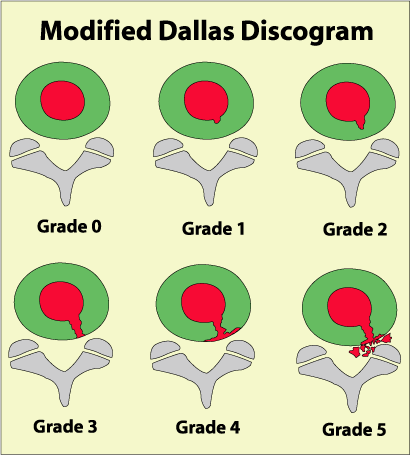UCSD Musculoskeletal Radiology
bonepit.com
The Modified Dallas Discogram classification system
|
|
UCSD Musculoskeletal Radiology bonepit.com The Modified Dallas Discogram classification system
|
The Dallas Discogram Description: A classification system for radial tears.
Not all radial annular tears are alike. Most radial tears only extend partially into the annulus and do not reach the pain sensitive out 1/3 of the annulus. Therefore it became important to develop a way to classify the severity of these radial tears. Enter the Dallas Discogram Description.
The ‘Modified Dallas Discogram Description’ was finalized in the 1990’s and is the Gold Standard for the classification of Radial annular tears. It was initially developed by a group of researcher from Texas (14) and then ‘modified’ by Bogduk et al (7), and finally Schellhas et al (15). In a nutshell, the nucleus of the suspected disc will be injected with a contrast material, that will out-line the nucleus and/or and leaking tears. After a short time, the patient is taken to the CT and axial pictures of the disc are made. If the nucleus is ripped, the dye will have migrated down the tear. The degree of disc disruption is described by how far this dye migrates away from the center of the disc.
 There
are six possible categories that describe the severity of the radial annular
tear.
There
are six possible categories that describe the severity of the radial annular
tear.
The grade 0 is a normal disc; where no contract material leaks from the nucleus.
The grade 1 tear will leak contrast material only into the inner 1/3 of the annulus.
The grade 2 tear will leak contrast through the inner 1/3 and into the middle 1/3 of the disc.
The grade 3 tear will leak contrast through the inner and middle annulus. The contrast spills into the outer 1/3 of the annulus.
The grade 4 tear further describes a grade 3 tear. Not only does the contrast extend into the outer 1/3 of the annulus, but it is seen spreading concentrically around the disc. To qualify as a grade 4 tear the concentric spread must be greater than 30 degrees. Pathologically, this represents the merging of a full thickness radial tear with a concentric annular tear.
The ‘evil’ grade 5 tear describes either a grade 3 or grade 4 radial tear that has completely ruptured that outer layers of the disc and is leaking contract material out of the disc. This type of tear, which I most likely suffered from, can cause a chemical radiculopathy in one or both of the extremities and result in the dreaded